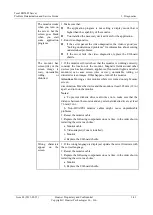
3 Diagnostics
Tecal RH5485 Server
Problem Determination and Service Guide
3-48
Huawei Proprietary and Confidential
Copyright © Huawei Technologies Co., Ltd.
Issue 02 (2011-05-25)
3.5.16 Universal Serial Bus (USB) port problems
Table 3-17
Universal Serial Bus (USB) port problems
Follow the suggested actions in the order in which they are listed in the
Action column until the problem is solved.
See Chapter 4, “Parts listing, ” to determine which components are customer
replaceable units (CRU) and which components are field replaceable units
(FRU).
If an action step is preceded by “(Trained service technician only),” that step
must be performed only by a trained service technician.
Symptom
Action
A USB device does
not work.
1. Run USB diagnostics.
2. Make sure that:
The correct USB device driver is installed.
The operating system supports USB devices.
3. Make sure that the USB configuration options are set correctly in the
Setup utility (see “Configuring the server” for more information).
4. If you are using a USB hub, disconnect the USB device from the hub
and connect it directly to the server.
3.5.17 Video problems
See “Monitor or video problems”.
3.6 Light path diagnostics
Light path diagnostics is a system of LEDs on various external and internal components of the
server. When an error occurs, LEDs are lit throughout the server. By viewing the LEDs in a
particular order, you can often identify the source of the error.
The server is designed so that LEDs remain lit when the server is connected to an ac power
source but is not turned on, provided that the power supply is operating correctly. This feature
helps you to isolate the problem when the operating system is shut down.
Any memory-card LED can be lit while the memory card is removed from the server so that
you can isolate a problem. After ac power has been removed from the server, power remains
available to these LEDs for up to 24 hours.
To view the memory card LEDs, press and hold the light path diagnostics button on the
memory card to light the error LEDs. The LEDs that were lit while the server was turned on
will be lit again while the button is pressed.
Many errors are first indicated by a lit information LED or system-error LED on the operator
information panel on the front of the server. If one or both of these LEDs are lit, one or more
LEDs elsewhere in the server might also be lit and can direct you to the source of the error.






























